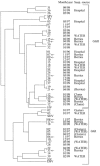Foodborne viruses
- PMID: 12069883
- PMCID: PMC7110323
- DOI: 10.1111/j.1574-6976.2002.tb00610.x
Foodborne viruses
Abstract
Foodborne and waterborne viral infections are increasingly recognized as causes of illness in humans. This increase is partly explained by changes in food processing and consumption patterns that lead to the worldwide availability of high-risk food. As a result, vast outbreaks may occur due to contamination of food by a single foodhandler or at a single source. Although there are numerous fecal-orally transmitted viruses, most reports of foodborne transmission describe infections with Norwalk-like caliciviruses (NLV) and hepatitis A virus (HAV), suggesting that these viruses are associated with the greatest risk of foodborne transmission. NLV and HAV can be transmitted from person to person, or indirectly via food, water, or fomites contaminated with virus-containing feces or vomit. People can be infected without showing symptoms. The high frequency of secondary cases of NLV illness and - to a lesser extent - of hepatitis A following a foodborne outbreak results in amplification of the problem. The burden of illness is highest in the elderly, and therefore is likely to increase due to the aging population. For HAV, the burden of illness may increase following hygienic control measures, due to a decreasing population of naturally immune individuals and a concurrent increase in the population at risk. Recent advances in the research of NLV and HAV have led to the development of molecular methods which can be used for molecular tracing of virus strains. These methods can be and have been used for the detection of common source outbreaks. While traditionally certain foods have been implicated in virus outbreaks, it is clear that almost any food item can be involved, provided it has been handled by an infected person. There are no established methods for detection of viruses in foods other than shellfish. Little information is available on disinfection and preventive measures specifically for these viruses. Studies addressing this issue are hampered by the lack of culture systems. As currently available routine monitoring systems exclusively focus on bacterial pathogens, efforts should be made to combine epidemiological and virological information for a combined laboratory-based rapid detection system for foodborne viruses. With better surveillance, including typing information, outbreaks of foodborne infections could be reported faster to prevent further spread.
Figures


Similar articles
-
Foodborne viruses: an emerging problem.Int J Food Microbiol. 2004 Jan 1;90(1):23-41. doi: 10.1016/s0168-1605(03)00169-7. Int J Food Microbiol. 2004. PMID: 14672828 Free PMC article. Review.
-
Development of methods to detect "Norwalk-like viruses" (NLVs) and hepatitis A virus in delicatessen foods: application to a food-borne NLV outbreak.Appl Environ Microbiol. 2000 Jan;66(1):213-8. doi: 10.1128/AEM.66.1.213-218.2000. Appl Environ Microbiol. 2000. PMID: 10618226 Free PMC article.
-
Laboratory capability in Europe for foodborne viruses.Euro Surveill. 2002 Apr;7(4):61-5. doi: 10.2807/esm.07.04.00323-en. Euro Surveill. 2002. PMID: 12631939
-
Outbreak of Norwalk virus in a Caribbean island resort: application of molecular diagnostics to ascertain the vehicle of infection.Epidemiol Infect. 2001 Jun;126(3):425-32. doi: 10.1017/s0950268801005556. Epidemiol Infect. 2001. PMID: 11467799 Free PMC article.
-
Microbial agents associated with waterborne diseases.Crit Rev Microbiol. 2002;28(4):371-409. doi: 10.1080/1040-840291046768. Crit Rev Microbiol. 2002. PMID: 12546197 Review.
Cited by
-
Common and Potential Emerging Foodborne Viruses: A Comprehensive Review.Life (Basel). 2024 Jan 28;14(2):190. doi: 10.3390/life14020190. Life (Basel). 2024. PMID: 38398699 Free PMC article. Review.
-
Hepatitis a Vaccine as Opportunity of Primary Prevention for Food Handlers: A Narrative Review.Vaccines (Basel). 2023 Jul 21;11(7):1271. doi: 10.3390/vaccines11071271. Vaccines (Basel). 2023. PMID: 37515087 Free PMC article. Review.
-
Impact of irrigation water quality on human norovirus surrogate survival during leafy green production.Front Plant Sci. 2023 Apr 3;14:1128579. doi: 10.3389/fpls.2023.1128579. eCollection 2023. Front Plant Sci. 2023. PMID: 37077630 Free PMC article.
-
Global public health implications of human exposure to viral contaminated water.Front Microbiol. 2022 Aug 30;13:981896. doi: 10.3389/fmicb.2022.981896. eCollection 2022. Front Microbiol. 2022. PMID: 36110296 Free PMC article. Review.
-
Can food matrices be considered as a potential carrier for COVID-19?Infez Med. 2022 Mar 1;30(1):59-72. doi: 10.53854/liim-3001-7. eCollection 2022. Infez Med. 2022. PMID: 35350257 Free PMC article. Review.
References
-
- Anon. (1995) Small round structured viruses (SRSV): numbers are increasing. Commun. Dis. Rep. CDR Wkly 5, 10. - PubMed
-
- Motarjemi, Y., Käferstein, F., Moy, G., Miyagishima, K., Miyagawa, S. and Reilly, A. (1995) Food Technologies and Public Health. WHO/FNU/FOS/95.12, Rome.
-
- De Wit, M. , Koopmans, M. , Kortbeek, T. , van Leeuwen, W. , Bartelds, A. , van Duynhoven, Y. (2001) c Sensor: a population‐based cohort study on gastroenteritis in the Netherlands: incidence and etiology. Am. J. Publ. Health 154, 666–674. - PubMed
-
- Wheeler, J.G. , Sethi, D. , Cowden, J.M. , Wall, P.G. , Rodrigues, L.C. , Tompkins, D.S. , Hudson, M.J. , Roderick, P.J. (1999) Study of infectious intestinal disease in England: rates in the community, presenting to the general practitioner, and reported to national surveillance. Br. Med. J. 318, 1046–1050. - PMC - PubMed
-
- Hedberg, C. , MacDonald, K. , Osterholm, M. (1994) Changing epidemiology of food‐borne disease: a Minnesota perspective. Clin. Infect. Dis. 18, 671–682. - PubMed
Publication types
MeSH terms
LinkOut - more resources
Full Text Sources
Medical
Research Materials

